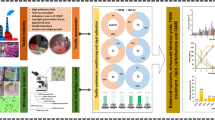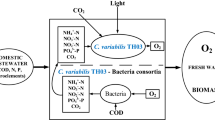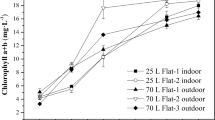Abstract
A cost-efficient process devoid of several washing steps was developed, which is related to direct cultivation following the decomposition of the sterilizer. Peracetic acid (PAA) is known to be an efficient antimicrobial agent due to its high oxidizing potential. Sterilization by 2 mM PAA demands at least 1 h incubation time for an effective disinfection. Direct degradation of PAA was demonstrated by utilizing components in conventional algal medium. Consequently, ferric ion and pH buffer (HEPES) showed a synergetic effect for the decomposition of PAA within 6 h. On the contrary, NaNO3, one of the main components in algal media, inhibits the decomposition of PAA. The improved growth of Chlorella vulgaris and Synechocystis PCC6803 was observed in the prepared BG11 by decomposition of PAA. This process involving sterilization and decomposition of PAA should help cost-efficient management of photobioreactors in a large scale for the production of value-added products and biofuels from microalgal biomass.





Similar content being viewed by others
References
Singh NK, Dhar DW (2011) Microalgae as second generation biofuel A review. Agron Sustain Dev 31:605–629
Ugwu CU, Aoyagi H, Uchiyama H (2008) Photobioreactors for mass cultivation of algae. Bioresour Technol 99:4021–4028
Lehr F, Posten C (2009) Closed photo-bioreactors as tools for biofuel production. Curr Opin Biotechnol 20:280–285
Kheshgi HS, Prince RC, Marland G (2000) The potential of biomass fuels in the context of global climate change: focus on transportation fuels. Annu Rev Energy Env 25:199–244
Stephens E, Ross IL, Mussgnug JH, Wagner LD, Borowitzka MA, Posten C, Kruse O, Hankamer B (2010) Future prospects of microalgal biofuel production systems. Trends Plant Sci 15:554–564
Morweiser M, Kruse O, Hankamer B, Posten C (2010) Developments and perspectives of photobioreactors for biofuel production. Appl Microbiol Biotechnol 87:1291–1301
Rutala WA, Weber DJ (1999) Infection control: the role of disinfection and sterilization. J Hosp Infect 43:S43–S55
Pflug IJ, Evans KD (2000) Carrying out biological qualification, the control operation of moist-heat (steam sterilization) processes for producing sterile pharmaceuticals and medical devices. PDA J Pharm Sci Technol 54:117–135
Pedersen LF, Meinelt T, Straus DL (2013) Peracetic acid degradation in freshwater aquaculture systems and possible practical implications. Aquacult Eng 53:65–71
Barbusinski K (2009) Fenton reaction-controversy concering the chemistry. Ecol Chem Eng S 16:347–358
Yuan Z, Ni Y, Van Heiningen A (1997) Kinetics of the peracetic acid decomposition: part II: pH effect and alkaline hydrolysis. Can J Chem Eng 75:42–47
Harris E (1989) The Chlamydomonas sourcebook. Academic Press, San Diego
Kitis M (2004) Disinfection of wastewater with peracetic acid: a review. Environ Int 30:47–55
Baldry MGC (1983) The bactericidal, fungicidal and sporicidal properties of hydrogen-peroxide and peracetic-acid. J Appl Bacteriol 54:417–423
Gehr R, Cochrane D (2002) Peracetic acid (PAA) as a disinfectant for municipal wastewaters: encouraging performance results from physiochemical as well as biological effluens. Proc Water Environ Fed 2002:182–198
Kunigk L, Gomes DR, Forte F, Vidal KP, Gomes LF, Sousa PF (2001) The influence of temperature on the decomposition kinetics of peracetic acid in solutions. Braz J Chem Eng 18:217–220
Molik S, Karnauchov I, Weidlich CE, Herrmann RG, Klosgen RB (2001) The Rieske Fe/S protein of the cytochrome b6/f complex in chloroplasts- missing link in the evolution of protein transport pathways in chloroplasts? J Biol Chem 276:42761–42766
Badarau A, Firbank SJ, Waldron KJ, Yanagisawa S, Robinson NJ, Banfield MJ, Dennison C (2008) FutA2 is a ferric binding protein from Synechocystis PCC 6803. J Biol Chem 283:12520–12527
Shcolnick S, Summerfield TC, Reytman L, Sherman LA, Keren N (2009) The mechanism of iron homeostasis in the unicellular cyanobacterium Synechocystis sp. PCC 6803 and its relationship to oxidative stress. Plant Physiol 150:2045–2056
Kwon JH, Rogner M, Rexroth S (2012) Direct approach for bioprocess optimization in a continuous flat-bed photobioreactor system. J Biotechnol 162:156–162
Baicu SC, Taylor MJ (2002) Acid-base buffering in organ preservation solutions as a function of temperature: new parameters for comparing buffer capacity and efficiency. Cryobiology 45:33–48
Lardon L, Helias A, Sialve B, Steyer JP, Bernard O (2009) Life-cycle assessment of biodiesel production from microalgae. Environ Sci Technol 43:6475–6481
Parmar A, Singh NK, Pandey A, Gnansounou E, Madamwar D (2011) Cyanobacteria and microalgae: a positive prospect for biofuels. Bioresour Technol 102:10163–10172
Acknowledgments
This work was supported by the Advanced Biomass R&D Center (ABC) of Global Frontier Project funded by the Ministry of Science, ICT & Future Planning (ABC-2010-K0029728).
Author information
Authors and Affiliations
Corresponding authors
Electronic supplementary material
Below is the link to the electronic supplementary material.
Rights and permissions
About this article
Cite this article
Sung, MG., Lee, H., Nam, K. et al. A simple method for decomposition of peracetic acid in a microalgal cultivation system. Bioprocess Biosyst Eng 38, 517–522 (2015). https://doi.org/10.1007/s00449-014-1291-5
Received:
Accepted:
Published:
Issue Date:
DOI: https://doi.org/10.1007/s00449-014-1291-5




